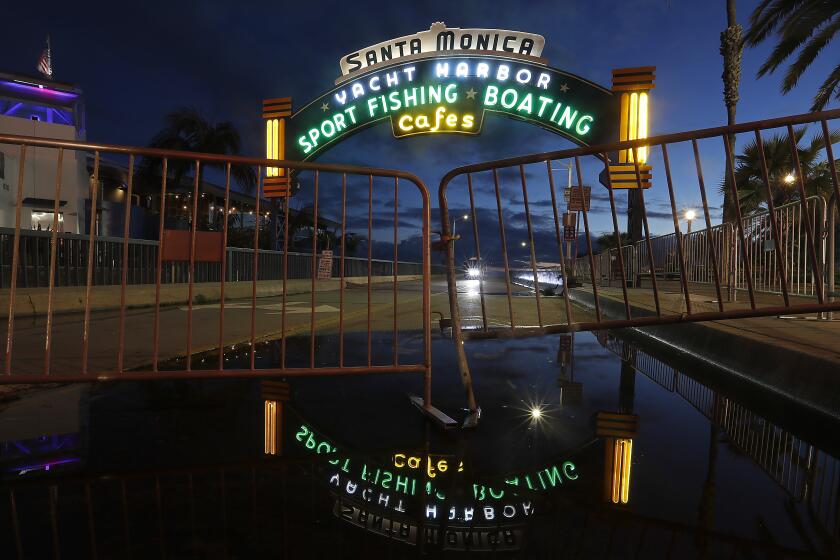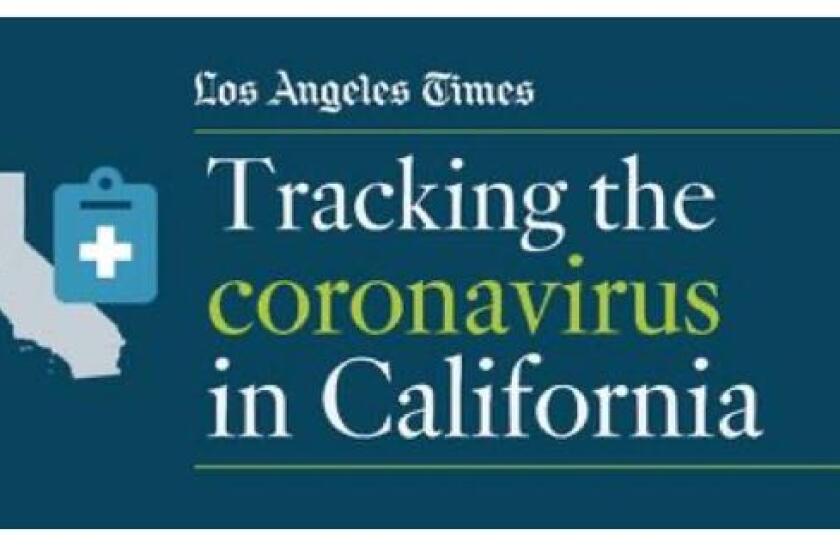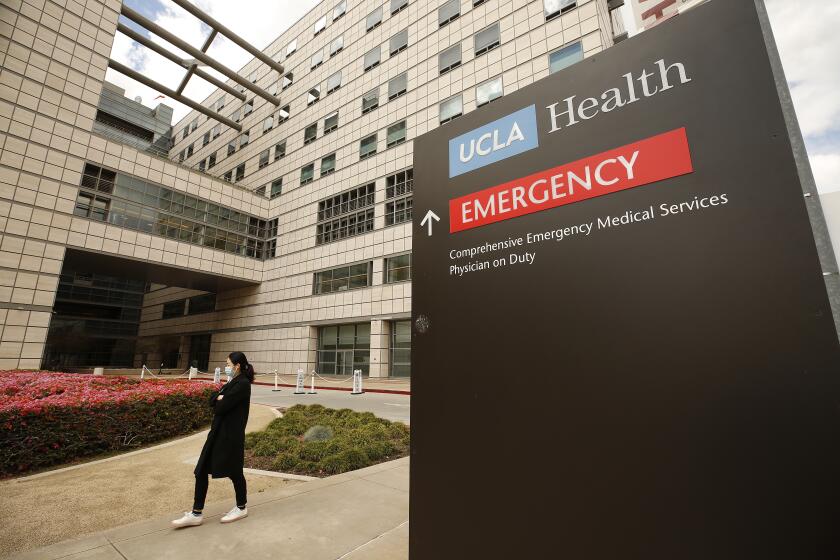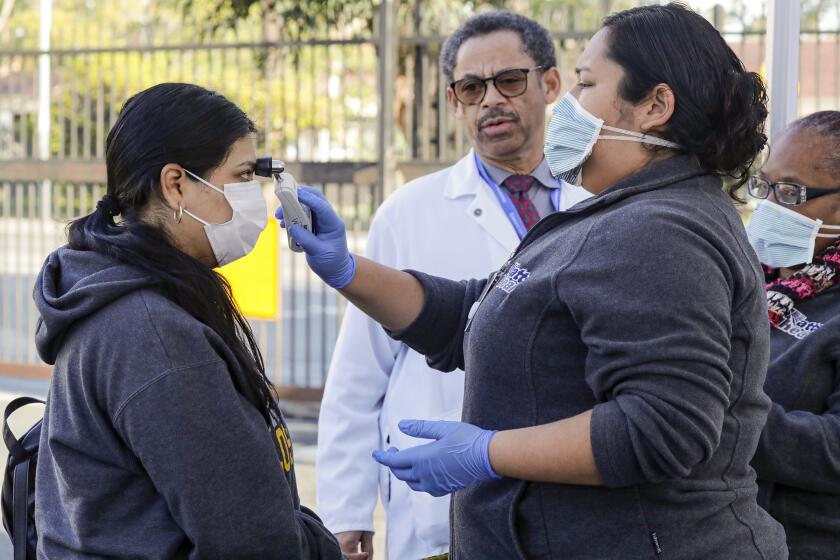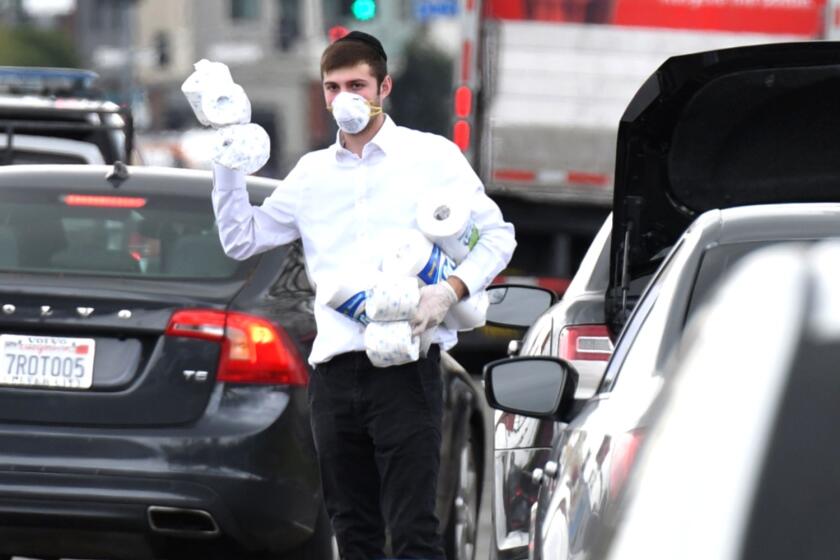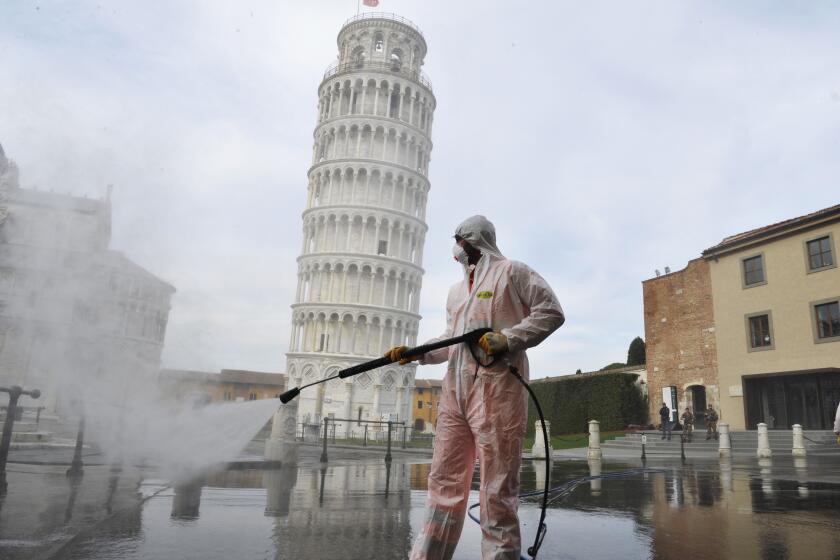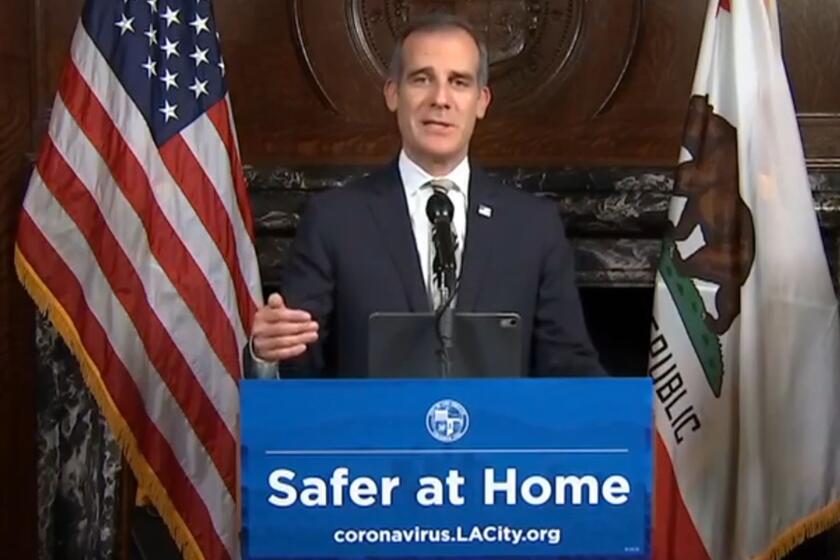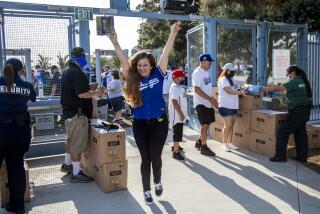L.A. County reports first death of a possible coronavirus patient under 18 as COVID-19 cases top 660
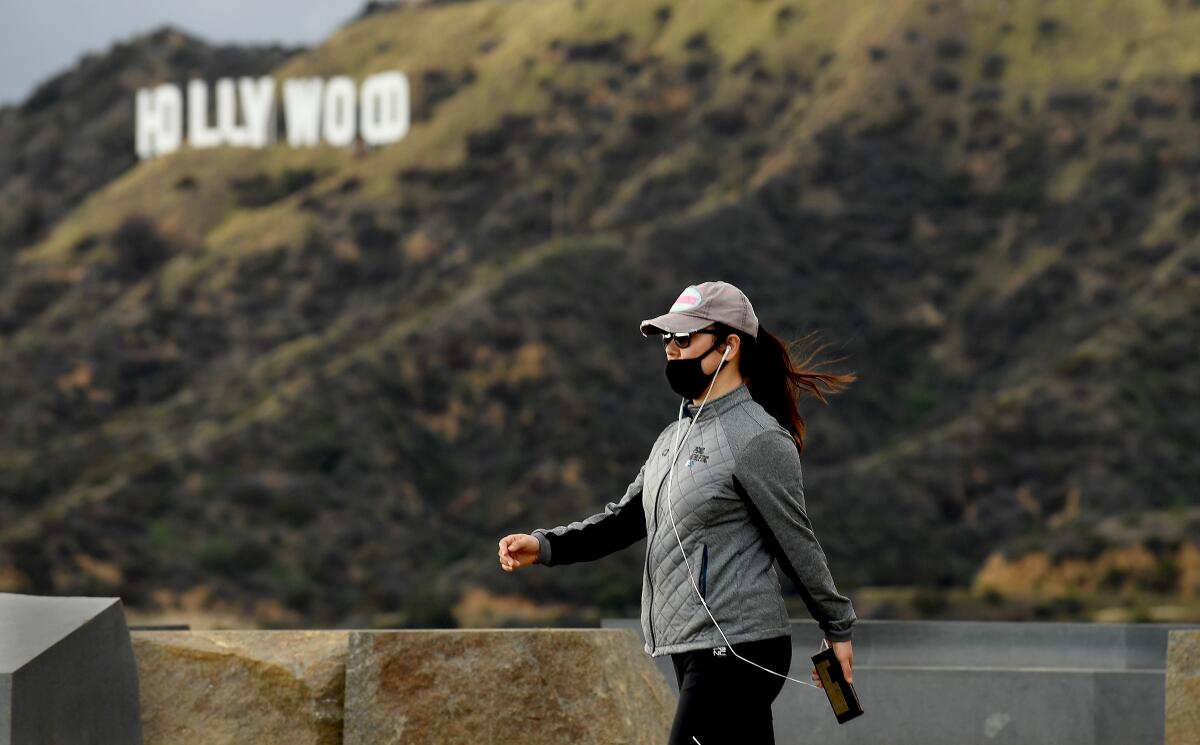
Mayor Eric Garcetti warned Los Angeles on Tuesday that the worst of the coronavirus pandemic was still to come and that residents should be prepared for more loss of life.
Garcetti said L.A. could be six to 12 days from seeing similar numbers to the outbreak in New York City, where the death toll has dramatically increased in recent days.
“It’s coming,” Garcetti said. “The peak is not here yet. The peak will be bad. People will lose their lives.”
The mayor also rebuffed President Trump’s earlier comments suggesting restrictions might be eased quickly and said that Angelenos should be “prepared for a couple months like this.”
“I know that everybody is hopeful, and some are putting out that hope of us being back in churches by Easter or synagogues by Passover, of restarting the economy in a couple weeks,” Garcetti said. “I think we owe it to everybody to be straightforward and honest that we will not be back to that [level of] normal in that short period of time.”
Garcetti’s warning came on the same day that Los Angeles County confirmed four more deaths linked to the novel coronavirus on Tuesday, including what might be the first fatality of a person younger than 18.
The latest updates from our reporters in California and around the world
The number of deaths in the county from the virus is now 11. Tuesday’s update also included a previously reported death in Long Beach.
Hours after announcing the juvenile’s death Tuesday, county heath officials issued a clarification that the death “will require further evaluation by the Centers for Disease Control and Prevention.”
“Though early tests indicated a positive result for COVID-19, the case is complex and there may be an alternate explanation for this fatality. Patient privacy prevents our offering further details at this time,” officials said.
The young victim, a teenager from Lancaster, died of septic shock, Lancaster Mayor R. Rex Parris told The Times. The teen’s father contracted the virus, Parris said.
“The father had close contact on the job with the public daily,” the mayor said. “This is truly awful, to lose a child.”
In response, Parris said, he is asking that all children stay indoors, and is working to secure 100,000 test kits.
“They aren’t testing hardly anybody,” Parris said. “So we aren’t going to wait for the county. We are going to provide our own tests.”
Two of the people who died were between the ages of 50 and 70. One had underlying health issues and resided in the West Adams neighborhood, health officials said.
“This is a devastating reminder that COVID-19 affects people of all ages,” L.A. County Public Health Department Director Barbara Ferrer said.
The Public Health Department said it was working to confirm whether the case marks the first such death of a minor linked to coronavirus in the country. Garcetti said he was informed by county officials that the Lancaster teen did not have any preexisting conditions.
Authorities also confirmed an additional 128 cases of coronavirus infection, bringing the county’s total to 662. Of those, 42% are people ages 18 to 40, and 39% are people 41 to 65.
At least 119 residents, or 18% of all positive cases in the county, have been hospitalized for the virus.
Eerie photos and stunning aerial shots show what California looks like under Gov. Newsom’s “stay at home” order.
At his news conference Tuesday afternoon, Garcetti said that his office is still receiving daily reports of nonessential businesses that continue to operate as normal — behavior he called “irresponsible and selfish.”
He announced a Safer at Home business ambassadors initiative that aims to help push greater adherence from nonessential businesses to the city’s order to close. Businesses that ignore the order should also expect to get a warning call from prosecutors before the city takes more aggressive action, including turning off their water and power, the mayor said.
“The easiest way to avoid a visit from the city is to follow the rules,” Garcetti said.
The city has not cited any nonessential businesses so far, according to a spokesperson for the mayor’s office. The total number of complaints filed was not available.
There are 40 business ambassadors assigned to enforcement of the nonessential business order. Residents can report scofflaws here.
More cases confirmed throughout state
In Orange County, officials announced 27 new cases, bringing the total to 152. The county’s first death was reported Tuesday.
San Mateo County saw a jump of 19 new cases, pushing its total to 161, and its second fatality. The number of cases increased by more than 10% in one day, according to Preston Merchant, a public information officer working in the county’s joint information center.
The latest death was of a resident at the Atria Senior Living facility in Burlingame, which learned on March 15 that a number of residents had tested positive. Monday’s fatality was the first of a resident related to the coronavirus.
“Our thoughts are with their family during this difficult time,” Atria said in a statement. “We remain in close communication with all our residents and their families and continue to provide our support as we navigate this unprecedented situation together.”
Atria said it was working closely with the San Mateo County Health Department, and officials have been on site to confirm proper health and safety measures are in place.
The number of coronavirus cases in California surged to nearly 2,500 Tuesday afternoon and the death toll climbed to at least 51 as officials issued urgent warnings about the need for more hospital beds and equipment as medical facilities begin to fill up.
Gov. Gavin Newsom says he believes California will need 50,000 hospital beds for patients suffering from COVID-19, the illness caused by the coronavirus. That marks a significant increase from the 20,000 beds his administration forecast last week. The Democratic governor said the state’s 416 hospitals were doubling their “surge plans,” a move that will result in 30,000 new beds across the system.
San Francisco officials warned that a surge in coronavirus infections was expected to come within a week or two, and voiced dismay over images of the public crowding beaches and parks across California.
Advice from an ER doctor: “If you can’t think clearly and can’t breathe and speak normally … that’s a reason to come in.”
“The worst is yet to come,” Dr. Grant Colfax, San Francisco’s director of public health, said at a news conference Monday.
San Francisco has already taken steps to decompress the healthcare system — banning almost all visitors to hospitals and long-term-care facilities, canceling elective surgeries and routine medical visits, ordering that appointments be done by phone or video if possible, and opening up tents to care for patients who have mild symptoms in order to keep hospital beds free for those more seriously ill.
A steep rise in people being hospitalized with COVID-19 in Los Angeles County probably signals the approach of a wave of extremely sick patients that could overwhelm hospitals in the coming weeks, experts say.
As of March 6, five people in the county had been hospitalized at some point with COVID-19. Two weeks later, on Friday, that figure had jumped to 48. By Monday, the total had climbed to 90.
Though the raw numbers remain relatively low, the rate of increase has set many doctors and nurses on edge after watching the disease’s alarming trajectory in China, Italy and, most recently, New York City.
A Nobel laureate predicted China’s recovery weeks before it happened. Analyzing the numbers, he sees a much brighter global outcome than many experts.
In Long Beach, Mayor Robert Garcia tweeted Tuesday that the city is now up to 28 confirmed COVID-19 cases.
“If you have the ability to stay home, please do so,” Garcia wrote. “Wash your hands and social distance. We all need to work to flatten the curve.”
Art Marroquin, spokesman for the city’s joint information center, said Long Beach’s 28 cases include one of two Cal State Long Beach students who tested positive for the virus and were in self-isolation off campus. The student was included because they are a Long Beach resident.
One student had not been on campus for two weeks, the university said. In the second case, public health officials determined there was no opportunity for on-campus exposure. Students who might have come into close contact with the patients were being notified by health officials, according to the email.
More testing needed
As the number of cases continues to rise, officials throughout the state kept up their call for an increase in testing capacity and reporting.
Frustrated public health directors in six Bay Area counties have ordered an assortment of commercial, university and pop-up testing sites that are screening residents for COVID-19 to begin reporting not just the positive cases, but the negative results too.
All those presumed positive or who have tested positive for COVID-19 must self-isolate, and close contacts must self-quarantine.
Dr. Sara Cody said testing remains woefully inadequate as Santa Clara County wrestles with mounting deaths. As of Tuesday, 16 people had died in the county, more than half of the virus fatalities in California.
The Santa Clara County Sheriff’s Office confirmed four cases among its staff, including a deputy who is self-isolating at home.
California requires labs and hospitals to report known cases of COVID-19, but not the number of negative tests. Cody said that information is critical to tracking the spread of the virus. She warned that Santa Clara County’s current critical situation is a window into what will be seen in San Francisco and other Bay Area communities in the next one to two weeks.
Contra Costa County is one of the six counties that ordered new requirements. On Friday, health officer Chris Farnitano said the county would issue an order for negative tests to be reported as well.
Closures remain in place
Meanwhile, California remains largely shut down under state and local orders. L.A. County officials have cracked down on nonessential businesses, which Sheriff Alex Villanueva declared Tuesday includes gun stores. If gun sellers don’t close their doors, he said, they will be cited and face penalty, including the loss of their business licenses.
Officials previously closed beach parking lots, parks and hiking trials amid concerns some people were not staying at least six feet apart while in public. Laguna Beach took the restrictions a step further and closed its beaches entirely on Monday.
More than 3,000 cases of coronavirus infection have been confirmed in California and 67 people have died of COVID-19. Will the state be the next Italy?
On Tuesday, Los Angeles City Councilman David Ryu called for the closure of Runyon Canyon Park and Lake Hollywood Park on weekends.
“Making this request pains me greatly. I grew up in a two-bedroom apartment off the 101 Freeway, and our city’s parks were my only access to outdoor space,” Ryu said of his recommendation to Michael Shull, the general manager of the city’s Department of Recreation and Parks. “I don’t make this recommendation easily, but closing Runyon Canyon Park on weekends, when we have seen the highest volume of visitors, should follow to keep everyone safe.”
In Sonoma County, all parks and open spaces were closed indefinitely, public health officials announced this week.
The closure includes city, county, state and federal parklands and recreational lands operated by private groups and nonprofits, according to a news release.
“Closing parks is a difficult decision, but it is the right decision at this time,” Sundari Mase, the county’s interim health officer, said in a statement. “Allowing crowded conditions in parks is not in our best interest during this health crisis. The best action we can take is to stay close to home and limit our outdoor time to our yards and neighborhoods.”
Mase announced the closure Monday after too many visitors flocked to outdoor spaces over the weekend.
Criminal and civil trials were discontinued in California for at least two months after a sweeping order was issued late Monday by the state’s chief justice that aimed to sharply reduce public traffic in state courthouses.
Chief Justice Tani G. Cantil-Sakauye said in her order that court facilities were “ill-equipped to effectively allow the social distancing and other public health requirements” that had been imposed across California to prevent the spread of the novel coronavirus.
“Even if court facilities could allow for sufficient social distancing, the closure of schools means that many court employees, litigants, witnesses, and potential jurors cannot leave their homes to attend court proceedings because they must stay home to supervise their children,” Cantil-Sakauye said in the order.
The 60-day delay — which puts the courts in California’s 58 counties on a uniform trial delay schedule — came the same day that the presiding judge of Los Angeles County Superior Court, Kevin C. Brazile, blocked public access to county courthouses except for attorneys, staff, defendants and “authorized persons,” a vague category that includes news reporters. The clerk’s office will still be available to accept filings and assist people by phone or electronically.
Los Angeles businesses should expect to receive a warning call from prosecutors before the city turns off their water and power, Mayor Eric Garcetti said.
The California National Guard on Monday provided details about how personnel would be deployed across the state to assist in coronavirus aid. Officials said the guard was being used purely for humanitarian purposes, such as distributing food and medical supplies as well as helping at food banks and working with officials on the Grand Princess cruise ship, which docked in California after an outbreak of the virus on board.
With the coronavirus pandemic further stifling the efforts of California and other states to issue Real ID licenses, President Trump on Monday said he would extend the Oct. 1 deadline for people to apply for the identification cards to board domestic flights in the United States.
Times staff writers Priscella Vega, Paige St. John and Luke Money contributed to this report.
More to Read
Sign up for Essential California
The most important California stories and recommendations in your inbox every morning.
You may occasionally receive promotional content from the Los Angeles Times.

